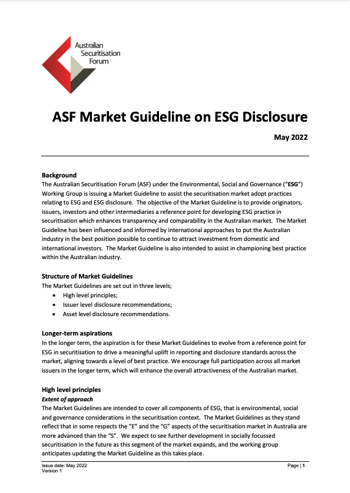
ESG guidelines for the securitisation sector
A reference point for originators, issuers, investors and other intermediaries in developing sustainability practice in securitisation that enhances transparency and comparability in the Australian market.
As a specialist investor in emissions reduction, the CEFC has played a leading role in the market development and issuance of climate or green fixed income products in Australia – with substantial investments in securitisation funding across the auto, personal loan and home mortgage sectors.
About the guidelines
ASF Market Guideline on ESG Disclosure
May 2025
The Market Guideline was developed by a working group convened by the Australian Securitisation Forum (ASF), the leading industry body representing participants in the securitisation and covered bond markets.
Read moreThe Market Guideline is intended to assist in championing best practice within the Australian industry. In the longer term, the aspiration is for these Market Guidelines to evolve from a reference point for sustainability in securitisation to drive a meaningful uplift in reporting and disclosure standards across the market, aligning towards a level of best practice.
about the industry
The ASF working group brings together issuers, investors and other market participants with the common goal of advancing the market’s approach to environmental, social and governance (ESG) considerations.
ESG reporting is a growing focus of all investors in the Australian market and is becoming increasingly important for investors in considering investment decisions.
The ASF ESG Working Group intends that the Market Guideline and other ESG related efforts sponsored by the ASF are supported by regular industry engagement through information sharing, training and other approaches to allow industry members to draw on the expertise within the industry.
Guideline update reflects changed disclosure practices
The first Market Guideline was issued in 2022 with an objective of continuing to attract investment from domestic and international investors. The 2025 Market Guideline updates the original to take into account movements in the market both domestically and globally. The changes which have been made to the Market Guideline reflect potential changed practices in the market around disclosure of alignment with frameworks such as the Australian Sustainable Finance Taxonomy. There are also some changes to allow for improved disclosure of specific green characteristics of the underlying financial assets being securitised.
High level principles
ESG industry leadership
The Market Guidelines reflect key high level principles:
- Extent: The market guidelines are intended to cover all ESG considerations in a securitisation context. As they stand, they reflect that in some respects the ‘E’ and the ‘G’ aspects of the securitisation market in Australia are more advanced than the ‘S’.
- Status: ESG is a growing focus of all investors in the Australian market and is becoming increasingly important. The intention of the working group is that the market guidelines operate in a nonbinding manner, with applicability being at the discretion of market participants. They are not intended to be mandatory in any sense and different market participants may elect how and when to apply the guidelines. Investors and others may have additional or different requirements, which they apply at their own discretion.
- Consistency and comparability between market participants is desirable where practically achievable, especially in the case of data disclosure. However, approaches to ESG may create different outcomes in securitisations even within the same asset class. As market participation increases, it is hoped that consistency and comparability will too.
- Incorporation of existing frameworks: The market guidelines allow issuers to take advantage of the work they are already doing. For instance, issuers that are disclosing their ESG approaches under Australian Securities Exchange or other listing requirements are able to incorporate this work by reference to avoid unnecessary duplication.
- Adaptability: Given the rapidly changing and expanding market focus on ESG globally, the market guidelines will be dynamic. There will be ongoing review via the working group to reflect changes and take on feedback.
- Ongoing industry engagement: Where possible, the guidelines have been structured to use independent and credible third-party reference sources and technical frameworks where claims are being made about ESG outcomes. This is to support the objectives of consistency, transparency and efficiency for all market participants. For instance, issuers are encouraged clearly to disclose assumptions under which any claims of CO2-e abatement are being made for green asset classes.





